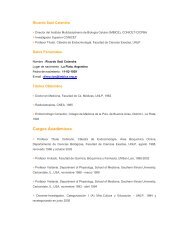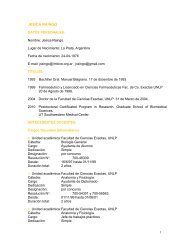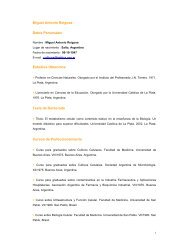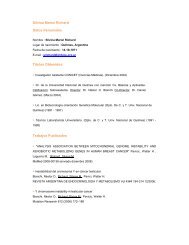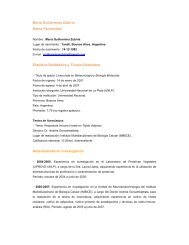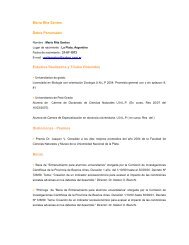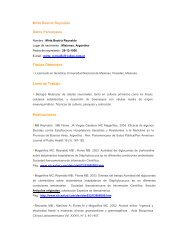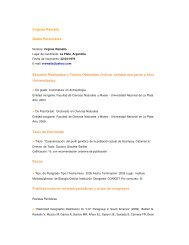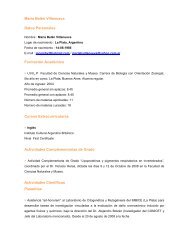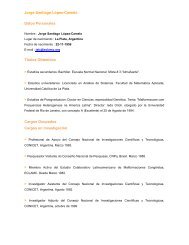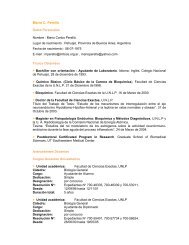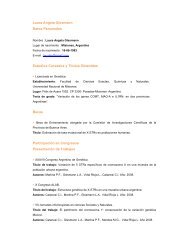Martha Susana Albarellos de Bianchi Datos Personales TÃtulos ...
Martha Susana Albarellos de Bianchi Datos Personales TÃtulos ...
Martha Susana Albarellos de Bianchi Datos Personales TÃtulos ...
Create successful ePaper yourself
Turn your PDF publications into a flip-book with our unique Google optimized e-Paper software.
<strong>Martha</strong> <strong>Susana</strong> <strong>Albarellos</strong> <strong>de</strong> <strong>Bianchi</strong><br />
<strong>Datos</strong> <strong>Personales</strong><br />
Nombre : <strong>Martha</strong> <strong>Susana</strong> <strong>Albarellos</strong> <strong>de</strong> <strong>Bianchi</strong><br />
Lugar <strong>de</strong> nacimiento : La Plata, Argentina<br />
Fecha <strong>de</strong> nacimiento : 31-08-1931<br />
E-mail : mabianchi@imbice.org.ar<br />
Títulos Académicos Obtenidos y Especialización<br />
>Profesión: Médico<br />
>Doctor en Medicina , Facultad <strong>de</strong> Ciencias Médicas, Universidad Nacional <strong>de</strong> La Plata<br />
(1959)<br />
>Especialista en Genética Médica (Sociedad Argentina <strong>de</strong> Genética, 1991).<br />
Cargos Académicos y Científicos Ocupados en la Actualidad<br />
>Investigador Principal CONICET (contratado)<br />
>Jefe <strong>de</strong>l Laboratorio <strong>de</strong> Citogenética y Mutagénesis (IMBICE)<br />
Líneas <strong>de</strong> Trabajo<br />
> Estudio <strong>de</strong> la genotoxicidad <strong>de</strong> diversos compuestos antitumorales en células eucariotas:<br />
tiene por finalidad el estudio <strong>de</strong> los efectos tóxicos <strong>de</strong> diversos agentes físicos y químicos<br />
sobre el ADN y cromosomas <strong>de</strong> organismos eucariotas, principalmente mamíferos. En el<br />
marco <strong>de</strong> esta línea, se <strong>de</strong>sarrollan en la actualidad las siguientes sublíneas:<br />
> I<strong>de</strong>ntificación y análisis <strong>de</strong> aberraciones cromosómicas inducidas por mutágenos químicos<br />
mediante FISH con sonda telomérica. Se analizan los llamados elementos cromosómicos<br />
incompletos (elementos cromosómicos con un solo telómero) y fragmentos acéntricos<br />
inducidos por los mutágenos bleomicina, estreptonigrina y estreptozotocina en células <strong>de</strong><br />
mamíferos, con el fin <strong>de</strong> profundizar en los mecanismos <strong>de</strong> origen <strong>de</strong> las aberraciones<br />
cromosómicas inducidas por mutágenos químicos en células eucariotas. En colaboración con<br />
el Dr. Alejandro Bolzán (IMBICE, La Plata).
Análisis <strong>de</strong> daño cromosómico espontáneo e inducido por mutágenos químicos en personal<br />
aeronáutico <strong>de</strong> la Argentina. El objetivo principal <strong>de</strong> este proyecto es establecer si el personal<br />
aeronáutico muestra hipersensibilidad cromosómica a los mutágenos químicos y, por lo tanto,<br />
constituye una población <strong>de</strong> alto riesgo para el <strong>de</strong>sarrollo <strong>de</strong> carcinogénesis ambiental, o, por<br />
el contrario, su exposición crónica a la radiación cósmica le confiere resistencia al daño<br />
cromosómico inducido por mutágenos químicos. En colaboración con el Dr. Alejandro Bolzán<br />
(IMBICE, La Plata).<br />
> Efecto <strong>de</strong> los compuestos tiólicos sobre el daño inducido por mutágenos químicos en el<br />
ADN y cromosomas <strong>de</strong> mamíferos. Esta sublínea <strong>de</strong> investigación se <strong>de</strong>sarrolla en<br />
colaboración con los Dres. Daniel López-Larraza y Alejandro Bolzán (IMBICE, La Plata).<br />
Publicaciones: 93 (Últimos 5 años: 22)<br />
> Bolzán AD, <strong>Bianchi</strong> MS. Analysis of streptozotocin-induced incomplete chromosome<br />
elements and excess acentric fragments in Chinese hamster cells using a telomeric PNA<br />
probe. Mutat. Res. 570:237-244 (2005).<br />
> Bolzán AD, <strong>Bianchi</strong> MS. Analysis of streptonigrin-induced incomplete chromosome<br />
elements and interstitial fragments in Chinese hamster cells using a telomeric PNA probe.<br />
Environ. Mol. Mutagen. 44:277-282 (2004).<br />
> Richard SM, <strong>Bianchi</strong> NO, <strong>Bianchi</strong> MS, Peltomäki P, Lothe RA, Pavicic W. Y<br />
chromosome instability in lymphoproliferative disor<strong>de</strong>rs. Mutat. Res. 554:45-51<br />
(2004).<br />
> Bolzán AD, Lacunza E, <strong>Bianchi</strong> MS. Effect of recombinant interferon alpha on<br />
streptozotocin-induced chromosome aberrations and sister-chromatid exchanges in hamster<br />
cells. Toxicol. In Vitro 18:901-905 (2004).<br />
> Bolzán AD, <strong>Bianchi</strong> MS. Detection of incomplete chromosome elements and interstitial<br />
fragments induced by bleomycin in hamster cells using a telomeric PNA probe. Mutat. Res.<br />
554:1-8 (2004).<br />
> Bolzán AD, <strong>Bianchi</strong> MS. Clastogenic effects of streptozotocin on human colon cancer<br />
cell lines with gene amplification. J. Environ. Pathol. Toxicol. Oncol. 22:281-286 (2003).<br />
> Richard SM, Knuutila S, Peltomäki P, <strong>Bianchi</strong> MS, <strong>Bianchi</strong> NO. Y chromosome instability in<br />
lymphoproliferative disor<strong>de</strong>rs. Mutat. Res., 525:103-107 (2003).
Lizarral<strong>de</strong> M, Bolzán AD, <strong>Bianchi</strong> MS. Karyotypic evolution in south american subterranean<br />
ro<strong>de</strong>nts Ctenomys magellanicus (Ro<strong>de</strong>ntia Octodontidae): chromosome rearrangements and<br />
(TTAGGG)n telomeric sequence localization in 2n = 34 and 2n = 36 chromosomal forms.<br />
Hereditas 139:13-17 (2003).<br />
> Bolzán AD, Lacunza E, <strong>Bianchi</strong> MS. Effect of recombinant interferon alpha on<br />
streptonigrin-induced chromosome aberrations and sister-chromatid exchanges in<br />
hamster cells. Mutat. Res. 522 :127-134 (2003).<br />
>Bolzán AD, <strong>Bianchi</strong> MS. Genotoxicity of streptozotocin. Mutat. Res. 512 :121-134 (2002).<br />
> <strong>Bianchi</strong> NO, Richard SM, Peltomäki P, <strong>Bianchi</strong> MS. Mosaic AZF <strong>de</strong>letions in human<br />
testicular tumors.Mutat. Res., 503 : 51-62 (2002).<br />
> Bolzán AD, Correa MV, <strong>Bianchi</strong> MS. Effect of recombinant interferon alpha on bleomycininduced<br />
chromosome damage in hamster cells. Mutat. Res. 505 :43-50 (2002).<br />
>Bolzán AD, <strong>Bianchi</strong> MS. Chromosomal response of human lymphocytes to streptozotocin.<br />
Mutat. Res. 503 :63-68 (2002).<br />
> Bolzán AD, <strong>Bianchi</strong> MS, Correa MV. Modulation of streptonigrin's clastogenic effects in CHO<br />
cells by the metal-chelating agent 1,10-Phenanthroline. Environ. Mol. Mutagen. 38 :306-310<br />
(2001).<br />
> Páez GL, Richard SM, <strong>Bianchi</strong> MS, <strong>Bianchi</strong> NO. Loss of heterozygosity (LOH) in 15q26.2-<br />
ter in breast cancer. Mutat. Res., 484: 193.106 (2001).<br />
><strong>Bianchi</strong> NO, <strong>Bianchi</strong> MS, Richard SM. Mitochondrial genome instability in human cancers.<br />
Mutat. Res. 488 :9-23 (2001).<br />
> Bolzán AD, Páez GL, <strong>Bianchi</strong> MS. FISH analysis of telomeric repeat sequences and<br />
their involvement in chromosomal aberrations induced by radiomimetic compounds in<br />
hamster cells. Mutat. Res. 479 : 187-196 (2001).<br />
>Bolzán AD, <strong>Bianchi</strong> MS. Genotoxicity of streptonigrin: A review. Mutat. Res. 488 :25-37<br />
(2001).<br />
> <strong>Bianchi</strong> MS, Bolzán AD, Páez GL, <strong>Bianchi</strong> NO. Telomeres, telomerase activity and<br />
gene amplification. J. Genet. Mol. Biol. 11 :47-54 (2000).
Bolzán AD, Páez GL, <strong>Bianchi</strong> MS, <strong>Bianchi</strong> NO. Analysis of telomeric repeats and telomerase<br />
activity in human colon carcinoma cells with gene amplification. Cancer Genet. Cytogenet.<br />
120: 166-170 (2000).<br />
> Bolzán AD, González MC, <strong>Bianchi</strong> MS. The effect of 1,10-Phenanthroline on the<br />
chromosome damage and sister-chromatid exchanges induced by streptozotocin in<br />
mammalian and insect cells. Mutat. Res. 447 :221-226 (2000).<br />
> Richard SM, Bailliet G, Páez GL, <strong>Bianchi</strong> MS, <strong>Bianchi</strong> NO. Nuclear and mitochondrial<br />
instability in human breast cancer. Cancer Res. 60 :4231-4237 (2000).<br />
Formación <strong>de</strong> Recursos Humanos<br />
Becarios<br />
> Gerardo L. Páez. Beca <strong>de</strong> Estudio CIC 1998. Plan <strong>de</strong> estudio: Análisis <strong>de</strong> las estructuras<br />
teloméricas y <strong>de</strong> la actividad telomerásica en células cancerosas humanas con amplificación<br />
génica.<br />
> Gerardo L. Páez. Prórroga <strong>de</strong> Beca <strong>de</strong> Estudio CIC 1999. Plan <strong>de</strong> estudio:<br />
Mecanismos <strong>de</strong> inestabilidad genómica y mitocondrial en tejido canceroso humano <strong>de</strong><br />
colon y mamario.<br />
> Gerardo L. Páez. Beca <strong>de</strong> Perfeccionamiento CIC 2000. Tema <strong>de</strong> Beca: Mecanismos<br />
<strong>de</strong> inestabilidad genómica y mitocondrial en tejido canceroso humano mamario.<br />
> Gerardo L. Páez. Prórroga <strong>de</strong> Beca <strong>de</strong> Perfeccionamiento CIC 2001: Tema <strong>de</strong> Beca:<br />
Análisis <strong>de</strong> pérdida <strong>de</strong> heterocigosidad <strong>de</strong>l cromosoma 15 en tejido canceroso mamario<br />
humano.<br />
> Silvina Mariel Richard. Beca <strong>de</strong> Estudio CIC 2000. Tema <strong>de</strong> Beca: Correlación <strong>de</strong> la<br />
inestabilidad genómica mitocondrial e inestabilidad genómica nuclear en cánceres Colorectales<br />
esporádicos. Director: Dr. Néstor O. <strong>Bianchi</strong>, Co-Director: Dra. <strong>Martha</strong> S.<br />
<strong>Albarellos</strong>.<br />
> Silvina Mariel Richard. Segundo año Beca <strong>de</strong> Estudio <strong>de</strong> CIC. Julio 2001-Julio 2002.<br />
Tema: Inestabilidad genómica nuclear y mitocondrial en diversas formas <strong>de</strong> cáncer en el<br />
ser humano. Director: Dr. Néstor O. <strong>Bianchi</strong>, Co-Director: Dra. <strong>Martha</strong> S. <strong>Albarellos</strong>.
Silvina Mariel Richard. Beca <strong>de</strong> Perfeccionamiento <strong>de</strong> CIC. Julio 2002-Julio 2004.<br />
Tema: Inestabilidad genómica en tumores <strong>de</strong> testículo humano. Director: Dr. Nestor O.<br />
<strong>Bianchi</strong>, Co-Director: Dra. <strong>Martha</strong> S. <strong>Albarellos</strong>.<br />
Personal <strong>de</strong> Apoyo a la Investigación<br />
>Miguel A. Reigosa. Profesional Principal CONICET, 1978 hasta la actualidad.<br />
>César Horgan. Profesional Principal CIC, 1982 hasta la actualidad.<br />
>Verónica Labarta. Personal <strong>de</strong> Apoyo CIC. Categoría Técnico Asistente, 2000 hasta la<br />
actualidad.<br />
> Miguel Belastegui. Personal <strong>de</strong> Apoyo CIC. Categoría Técnico Asistente, 1989 hasta la<br />
actualidad.<br />
Investigadores (últimos 5 años)<br />
> Alejandro Bolzán (1998-2002).<br />
Dirección <strong>de</strong> Tesis Doctorales (Últimos 5 años)<br />
> Mariana I. Testoni (Universidad Nacional <strong>de</strong> La Plata, 1998). Tema: "Mecanismos<br />
implicados en la genotoxicidad <strong>de</strong> la estreptonigrina y los metales pesados en<br />
células CHO".<br />
> Gerardo L. Páez. Tesis Doctoral. Tema: "Mecanismos <strong>de</strong> inestabilidad genómica y<br />
mitocondrial en tejido canceroso mamario humano". Presentada, aceptada y <strong>de</strong>fendida en la<br />
Facultad <strong>de</strong> Medicina <strong>de</strong> la Universidad <strong>de</strong> Buenos Aires, el 12 <strong>de</strong> Junio <strong>de</strong> 2003.<br />
Dirección <strong>de</strong> Tesinas <strong>de</strong> Licenciatura<br />
> Gerardo L. Páez (Facultad <strong>de</strong> Ciencias Exactas, Químicas y Naturales <strong>de</strong> la Universidad<br />
Nacional <strong>de</strong> Misiones, 1997). Tema: "PCR <strong>de</strong> baja especificidad con iniciador único en<br />
tejido mamario humano normal y tumoral.



